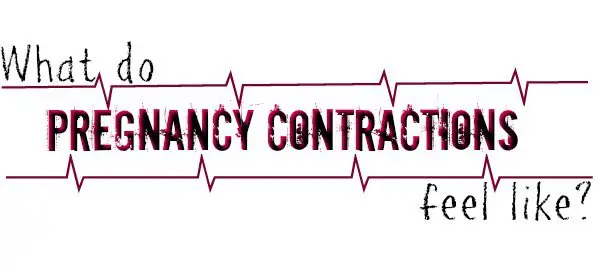After nine to ten long months of pregnancy you’re likely hoping every little twitch is a contraction. You think to yourself, “maybe I’m in labor now, and I just don’t know it,” and if this is your first child, how are you supposed to know? When are you in true labor? Should you be at the hospital? What do contractions feel like? As a mom of four, I’ll do my best to answer all of the above.
What is a pregnancy contraction, and what does it do?
Chances are you know what the word contraction means, and you understand that muscles contract and relax in the body to create movement and support. What you might not know, is that while your uterus is not a muscle itself, it is lined with a thick layer of smooth muscle. Pregnancy contractions are just the tightening and release of this muscle, much like you see when you flex and then straighten your arm.
It’s a misconception that contractions start during labor. In reality, they start much, much earlier. As early as 6 weeks in fact, many women just don’t feel them until the second trimester or so. These early contractions work to help tone and strengthen your uterus for labor. Later contractions help ripen your cervix and move your baby into position for labor. During labor, they may also help promote blood flow to your baby.
What do contractions feel like: by type
What do braxton hicks contractions feel like?
Braxton hicks contractions are the warm up for the real thing. They generally are more uncomfortable than painful. As mentioned above, these early contractions aren’t frequently felt until the second trimester, sometimes in the third. They can be brought on by physical activity, dehydration, a full bladder, or sexual intercourse among other things. Some women never feel their baxton hicks contractions. They will be irregular and usually go away with time or position changes.
You can tell braxton hicks contractions from labor contractions by tracking their occurrence.
If your contractions are:
-not occurring in a rhythmic pattern (such as every 10 minutes)
-not holding a consistent length (such as 30 seconds each time)
-not increasing in frequency, duration, or strength
-not felt in more than just your abdomen (rather than your sides, back, etc)
-go away with position changes
They are likely braxton hicks contractions, also sometimes referred to as “false labor.”
What do early labor contractions feel like?
At least in all of my labors, there was a distinct difference between early labor contractions and OMG-here-the-baby-comes contractions. Early labor contractions will occur at a steady rate of time and not decrease or go away with time or position changes like braxton hicks. They mark the start of your labor and will feel again like a tightening of your abdominal muscles, but because early labor contractions do affect your cervix, they may cause slight pain or discomfort.
Once early labor contractions occur every 5 to 10 minutes you should get to a hospital or contact your care provider if you’re birthing at home. Early labor contractions also tend to be wave-like and do subside. Depending on your pain tolerance level, you may not really feel these. In my labor where my water did break, the machine at the hospital registered contractions far before I felt them. In fact, I was dilated to a 6 before I felt anything at all. (10 is time to push)
What are other signs of labor?
If you can’t feel these contractions, some other signs of labor include:
-Increased vaginal discharge, which may be gooey, thick, or blood tinged
-Dilation and effacement of the cervix
-Lightening, or the drop of your baby lower into your pelvis
-A leaking of fluid which may be mistaken for urine (your water breaking is not always a “gush” of fluid)
-Sudden lower back pain (this is actually from contractions)
Side note, if you’re feeling a bit lost with some of this terminology, you might check out our page on pregnancy and labor terminology in simple terms.
What do transitional and active labor contractions feel like?
The only way I can think to explain the feeling of an active labor contraction is to image that achy painful throbbing that occurs when you smash a finger or toe. Now imagine this pain in your abdomen. As you move from active labor into transition (your actual delivery) you will also likely feel the urge to bear down and push or may feel like you have to poop. Some women equate the feeling of transitional labor contractions to that of very bad menstrual cramps. Either way, when contractions reach this extreme the baby is close. If you don’t have someone to deliver your baby, you need to get to them asap. Transitional labor contractions are less wave-like and hurt far more frequently. When these start you will know it.
In many labors, the bag of waters never breaks, mine didn’t with 2 of 4. Some women also lose a mucus plug from their cervix before or after early labor contractions begin. No single labor is the same and many women describe contractions in varying ways, but in my experience this is what contractions in the various forms feel like. I hope this has helped ease you’re wondering and waiting.
If you’re done waiting, congrats on your new baby! We’d love to hear how you would answer the question, “what do contractions feel like?”

